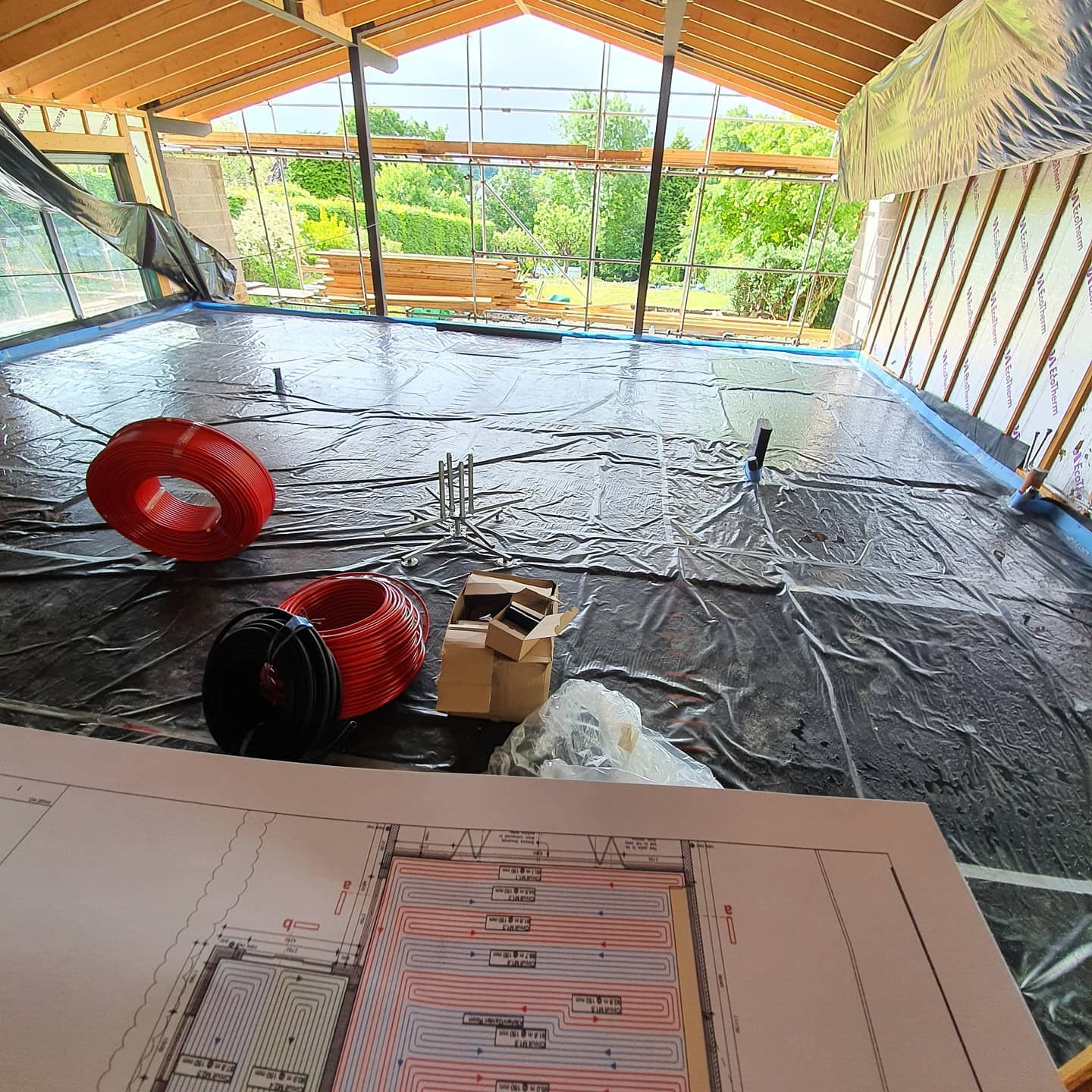Underfloor Heating Installation
At the Underfloor Heating Shop, we are experts in underfloor heating installation. With 30 years of combined experience, our team can ensure that you have economical heating for your home in no time.
Why underfloor heating?
Underfloor heating is increasingly becoming a more popular choice for businesses and homeowners in the UK. This type of heating offers increased comfort, warming your feet so that you can walk barefoot all year round. Underfloor heating is also energy efficient, unlike traditional radiators which need to be heated to a very high temperature. Plus, underfloor heating heats the entire room evenly, meaning you will have no cold areas.
Another benefit of underfloor heating is that it improves the design of your home, removing the need for radiators which take up space. It makes the most out of your current floor space whilst being hidden away. Plus, it is cheaper to run, with up to 20% lower energy costs than a traditional radiator system.
The installation process
At Underfloor Heating Shop, we make the underfloor heating installation process quick and easy. After viewing your home or site, we can offer you a no-obligation quote, and get to work on installing your heating. Most projects can be completed in one day which saves you hassle, and you will normally be able to use your underfloor heating within a week of installation. You can have any type of floor covering over underfloor heating, including carpet, tiles and laminate flooring.
Contact us
If you are looking to have underfloor heating installed, get in touch with Underfloor Heating Shop. Based in Sheffield but serving the majority of the UK, our team can visit your site or home to offer you a free quote. For more information, contact us today.
Photos of our work
Explore our gallery to see the high-quality underfloor heating installations we've completed. From residential to commercial projects, our work showcases the precision, efficiency, and durability of our systems.
Browse through our images to see how we bring warmth and comfort to every space.



Q: HOW MUCH DOES UNDERFLOOR HEATING COST TO RUN?
A: Water underfloor heating systems are typically 20% cheaper to run than a traditional radiator system powered by a gas boiler.
Q: WHAT FLOOR COVERINGS CAN I HAVE ON TOP OF UNDERFLOOR HEATING?
A: You can almost any type of floor covering over underfloor heating, this includes but not limited to: Amtico, Karndean, Marmoleum, Laminate, Engineered Wood, Carpet, Tiles and Stone.
Q: DO I NEED INSULATION?
A: Yes, the use of floor insulation plays a critical part in your underfloor heating working as efficient as possible. The more insulation you install in your property including walls will mean less energy needed to replace the heat loss which means cheaper bills.
Q: WHAT'S THE MAXIMUM THICKNESS OF FLOOR COVERING?
A: Engineered woods no more than 22mm, Stone and Ceramic tiles have a good thermal transfer. Carpet and underlays need to have a combined tog value of 2.5T or less, we recommend specialist underlays when choosing carpet.
Q: WHAT IS THE COST OF INSTALLING UNDERFLOOR HEATING?
A: The cost will depend on your project and the ease of installation. Most projects can be completed in one day and others take weeks such as large commercial installations. We look at each job on its own merits and listen to your needs, we can design a system that suits your property, we do not install systems that are not suitable for you or your property.
Q: DO I NEED A MEMBRANE OVER THE INSULATION?
A: Whether you are using sand and cement or flowing screeds, we recommend a vapour barrier over your insulation before your underfloor heating is installed. This should be cut square with your walls, overlapped and joints taped. Perimeter insulation must be installed to allow the slab to expand, the skirt is then taped to the vapour barrier.
Q: WHAT'S THE MINIMUM SCREED THICKNESS FOR UNDERFLOOR HEATING?
A: By selecting a typical liquid screed the minimum depth is 50mm, you can also get specialist liquid screeds that go as low as 40mm in certain circumstances. A traditional Sand and Cement screed is a minimum of 65-75mm.
Q: AFTER SCREEDING, HOW LONG BEFORE I CAN USE MY UNDERFLOOR HEATING?
A: It all depends on the type of screed, but some systems can be turned on as soon as 2 days after installation, others can be 7 days or even longer. Always check with manufacturer for guidance.
Q: WHAT'S THE DRYING TIME FOR FLOOR SCREED WITH UNDER FLOOR HEATING?
A: Again this is entirely dependent on the type of screed used. Consult your screeder or manufacturer for details.
Q: WHICH AREAS OF THE UK DO YOU COVER?
A: We cover majority of the UK, most of our work is in the midlands.
Q: WHAT HAPPENS IF MY WATER UNDERFLOOR HEATING DEVELOPS A LEAK?
A: The pipework is tested from factory and is very uncommon that it's compromised. Most leaks are caused by human error and water testing during the colder weather, you can repair the pipes once the leak has been located.
Q: SHOULD I LEAVE MY UNDERFLOOR HEATING ON ALL-DAY?
A: We suggest leaving the system ticking over during the day and using the set-back feature on the thermostats overnight to keep the heat in the floor and to not allow the slab to go completely cold. For example, if your day time temperature is 21oC, we suggest allowing the system to cool down to 17oC, then in the morning the heating system hasn't got to do a lot of work to come back up to 21oC.
Q: HOW MUCH TO INSTALL UNDERFLOOR HEATING?
A: No two projects are the same, there are too many factors to give an exact amount, what we will do is offer the best price and service we can and be as competitive as possible. If you would like a price on a project please fill out our online form or send an email to info@ufhs.co.uk.


